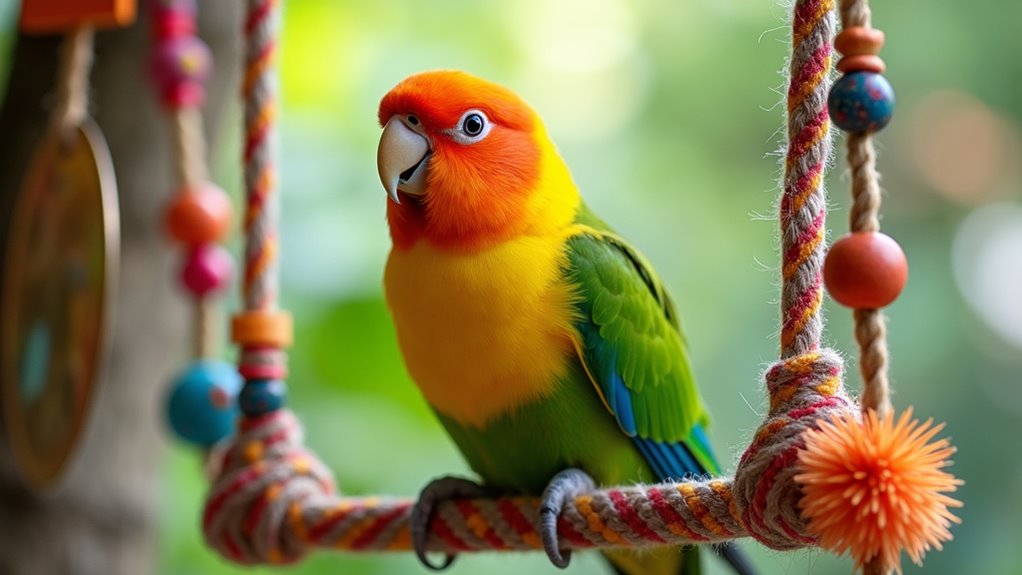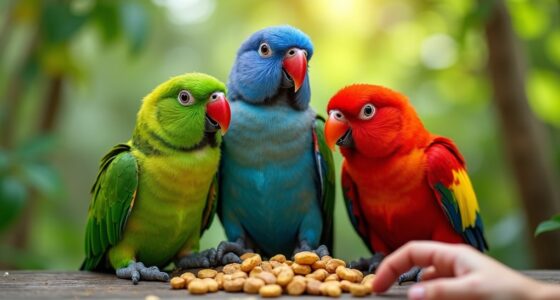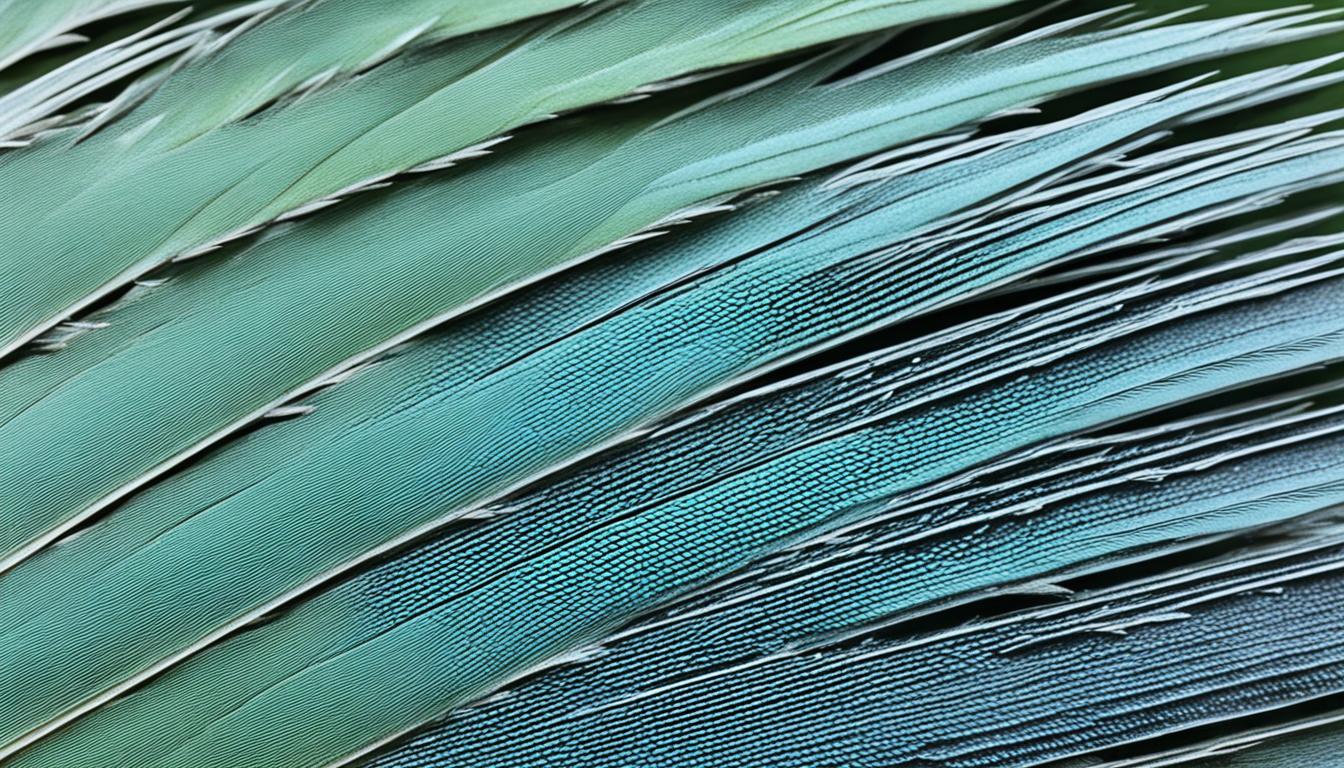To keep your bird entertained, make DIY toys using household items like paper, untreated wood, and natural fibers such as hemp or sisal. Create puzzles by hiding treats inside shredded paper or cardboard tubes, and hang toys to promote climbing. Regularly inspect and rotate them to prevent boredom. Incorporating sensory elements like bells and mirrors adds stimulation. For more creative ideas and safety tips, explore how DIY options can transform your bird’s environment.
Key Takeaways
- Use household items like shredded paper, cardboard tubes, and natural fibers to create safe, engaging toys tailored to your bird’s preferences.
- Incorporate various textures, shapes, and hiding treats inside toys to promote natural foraging, shredding, and problem-solving behaviors.
- Hang toys to encourage climbing and exploration, rotating them weekly to maintain your bird’s curiosity and prevent boredom.
- Regularly inspect and replace worn or damaged toys, ensuring no toxic or small parts that could be swallowed are present.
- Add sensory elements like bells or mirrors and include treats to stimulate mental activity and physical play for overall well-being.

Creating your own bird toys is a fun and cost-effective way to keep your feathered friend entertained and mentally stimulated. DIY bird toys not only save you money but also give you the opportunity to tailor activities specifically to your bird’s preferences and size. When making these toys, it’s essential to consider bird enrichment tips that promote natural behaviors like foraging, shredding, and climbing. By incorporating simple household items and safe materials, you can craft engaging toys that challenge your bird’s mind and body.
Start by gathering common household supplies such as paper, untreated wood, plastic, and natural fibers like hemp or sisal. These materials are safe for birds and easy to manipulate into various toys. For example, you can create a hanging puzzle by threading treats through strips of paper or weaving shredded paper into a ball. These DIY bird toys stimulate your bird’s curiosity and encourage problem-solving, which are vital for mental health. When designing toys, keep in mind bird enrichment tips like providing a variety of textures and shapes to prevent boredom and promote physical activity. Incorporating positive reinforcement techniques can further motivate your bird to engage with new toys and activities.
To make a simple yet effective toy, take a sturdy cardboard tube, stuff it with shredded paper or bird-safe treats, and hang it in your bird’s cage. This encourages your pet to forage and shred, mimicking natural behaviors. You can also attach small bells or mirrors to these toys for added stimulation. Remember, safety is key—avoid using glue, paints, or small parts that could be swallowed or cause injury. Regularly inspect your homemade toys for wear and tear, replacing them as needed to keep your bird safe.
Incorporating a range of DIY bird toys into your bird’s environment helps prevent boredom and reduces destructive behavior. Rotate toys weekly to keep your bird engaged and curious. Use bird enrichment tips like hiding treats inside toys to foster foraging instincts or creating multi-step puzzles that require your bird to solve a simple task to access a reward. These activities promote mental agility and keep your bird active and happy. Additionally, Mad Tasting snacks can be an appealing treat to include as a reward during playtime, encouraging your bird to interact with its toys more enthusiastically. With a little creativity and some basic supplies, you can turn everyday items into enriching playthings that your bird will love. Not only does this strengthen your bond, but it also guarantees your pet stays healthy, happy, and mentally stimulated.
Frequently Asked Questions
How Often Should I Rotate DIY Toys for My Bird?
To keep your bird engaged, you should rotate DIY toys regularly, ideally every one to two weeks. This toy rotation helps maintain your bird’s interest and prevents boredom. Stick to an enrichment schedule where you introduce new toys gradually, removing the older ones. Observe your bird’s reactions; if they lose interest quickly, consider more frequent rotation. Consistent variation keeps your bird mentally stimulated and happy.
Are There Any DIY Toys That Are Unsafe for Certain Bird Species?
You should always check if DIY toys are safe for your bird species, as some bird safe materials might be unsafe for others. Avoid using dangerous household items like glitters or toxic paints, which can harm your bird. Research specific needs for your bird species, and opt for non-toxic, bird-safe materials like untreated wood, natural fibers, and bird-safe plastics. Always supervise your bird with new toys to prevent accidents.
How Can I Tell if My Bird Is Bored or Overstimulated?
You can tell if your bird is bored or overstimulated by observing behavior cues. Bored birds often display signs like feather plucking, excessive sleeping, or vocalizations. Overstimulation signs include flapping, biting, or rapid movements. Watch closely and note changes in their activity levels. If your bird shows these cues, give it a break or change up its environment to help keep it comfortable and engaged.
What Materials Should I Avoid When Making Bird Toys?
When making bird toys, you should avoid toxic materials like lead, zinc, or glue with harmful chemicals, as they can harm your bird’s health. Also, steer clear of sharp objects that could injure your bird’s beak or feet. Use safe, bird-friendly materials like untreated wood, natural fibers, and non-toxic paints. Always double-check that all parts are smooth and secure to prevent choking or injury.
Can DIY Toys Replace All Store-Bought Enrichment Items?
Thinking about DIY vs. store-bought toys? You might wonder if homemade options can fully fulfill your bird’s needs. While DIY toys are cost-effective and customizable, they might not always replace store-bought items that are specifically designed for safety and stimulation. Combining both creates a balanced, budget-friendly approach, ensuring your feathered friend stays active, engaged, and entertained without sacrificing safety or variety.
Conclusion
By creating DIY toys and enrichment ideas, you transform your bird’s daily routine into an exciting adventure. Imagine your feathered friend, once bored and restless, now happily flapping and exploring, much like a child discovering new treasures. Just as a simple puzzle can brighten a person’s day, your homemade toys can bring joy, mental stimulation, and a stronger bond. Your effort turns your bird’s cage into a lively, colorful world they can’t wait to explore.










